| کد مقاله | کد نشریه | سال انتشار | مقاله انگلیسی | نسخه تمام متن |
|---|---|---|---|---|
| 6231150 | 1608139 | 2015 | 7 صفحه PDF | دانلود رایگان |

- PTSD negative mood is most strongly associated with affective depression.
- PTSD hyperarousal is most strongly associated with somatic depression.
- Across PTSD clusters, PTSD hyperarousal is most strongly associated with GAD.
- The interrelation among the clusters may explain the high rates of comorbidity.
Exposure to traumatic events places individuals at high risk for multiple psychiatric disorders, including posttraumatic stress disorder (PTSD), major depressive disorder (MDD), and generalized anxiety disorder (GAD). The high rates of comorbidity among these conditions merit evaluation in order to improve diagnosis and treatment approaches. The current study evaluated the association between PTSD, MDD, and GAD factors as presented in the DSM 5. 602 trauma-exposed individuals who experienced an event that met Criterion A for the DSM 5 PTSD diagnosis were recruited through Amazon.com, Inc.'s Mechanical Turk (MTurk) to complete an assessment of the impact of stressful events on their lives. High interrelations were detected among the 4 PTSD factors, 2 MDD factors that corresponded to somatic and affective symptoms, and the single GAD factor. The affective factor of MDD was most strongly related to the emotional numbing factor of PTSD, whereas the somatic factor of MDD was most strongly related to the hyperarousal factor of PTSD. The GAD factor was most strongly related to the hyperarousal factor of PTSD, relative to the other PTSD factors. The strength of the interrelations between factors of the three disorders is largely a function of the overlap in symptoms and calls into question the uniqueness of negative affective symptoms of PTSD, MDD and GAD. Results suggest that improved understanding of the trauma reaction requires a focus on the unique presentation of each individual and assessment of multiple disorders.
Journal: Journal of Affective Disorders - Volume 186, 1 November 2015, Pages 149-155